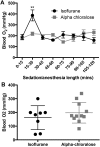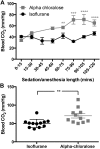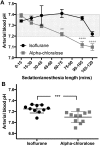Comparing the Effects of Isoflurane and Alpha Chloralose upon Mouse Physiology
- PMID: 27148970
- PMCID: PMC4858227
- DOI: 10.1371/journal.pone.0154936
Comparing the Effects of Isoflurane and Alpha Chloralose upon Mouse Physiology
Abstract
Functional magnetic resonance imaging of mice requires that the physiology of the mouse (body temperature, respiration and heart rates, blood pH level) be maintained in order to prevent changes affecting the outcomes of functional scanning, namely blood oxygenation level dependent (BOLD) measures and cerebral blood flow (CBF). The anesthetic used to sedate mice for scanning can have major effects on physiology. While alpha chloralose has been commonly used for functional imaging of rats, its effects on physiology are not well characterized in the literature for any species. In this study, we anesthetized or sedated mice with isoflurane or alpha chloralose for up to two hours, and monitored physiological parameters and arterial blood gasses. We found that, when normal body temperature is maintained, breathing rates for both drugs decrease over the course of two hours. In addition, alpha chloralose causes a substantial drop in heart rate and blood pH with severe hypercapnia (elevated blood CO2) that is not seen in isoflurane-treated animals. We suggest that alpha chloralose does not maintain normal mouse physiology adequately for functional brain imaging outcome measures.
Conflict of interest statement
Figures





Similar articles
-
Effects of isoflurane and alpha-chloralose anesthesia on BOLD fMRI responses to ingested L-glutamate in rats.Neuroscience. 2010 Jan 13;165(1):244-51. doi: 10.1016/j.neuroscience.2009.10.006. Epub 2009 Oct 9. Neuroscience. 2010. PMID: 19819307
-
Comparison of alpha-chloralose, medetomidine and isoflurane anesthesia for functional connectivity mapping in the rat.Magn Reson Imaging. 2010 Sep;28(7):995-1003. doi: 10.1016/j.mri.2010.03.007. Epub 2010 Apr 24. Magn Reson Imaging. 2010. PMID: 20456892 Free PMC article.
-
Cerebral blood flow and BOLD fMRI responses to hypoxia in awake and anesthetized rats.Brain Res. 2007 Mar 2;1135(1):186-94. doi: 10.1016/j.brainres.2006.11.097. Epub 2007 Jan 2. Brain Res. 2007. PMID: 17198686 Free PMC article.
-
The current functional state of local neuronal circuits controls the magnitude of a BOLD response to incoming stimuli.Neuroimage. 2010 May 1;50(4):1364-75. doi: 10.1016/j.neuroimage.2010.01.070. Epub 2010 Jan 28. Neuroimage. 2010. PMID: 20114080
-
Cerebrovascular responses under controlled and monitored physiological conditions in the anesthetized mouse.J Cereb Blood Flow Metab. 1995 Jul;15(4):631-8. doi: 10.1038/jcbfm.1995.78. J Cereb Blood Flow Metab. 1995. PMID: 7790412
Cited by
-
Brain tumors disrupt the resting-state connectome.Neuroimage Clin. 2018 Feb 28;18:279-289. doi: 10.1016/j.nicl.2018.01.026. eCollection 2018. Neuroimage Clin. 2018. PMID: 29876248 Free PMC article.
-
Anesthetic modulations dissociate neuroelectric characteristics between sensory-evoked and spontaneous activities across bilateral rat somatosensory cortical laminae.Sci Rep. 2022 Jul 8;12(1):11661. doi: 10.1038/s41598-022-13759-0. Sci Rep. 2022. PMID: 35804171 Free PMC article.
-
Oxygen imaging of hypoxic pockets in the mouse cerebral cortex.Science. 2024 Mar 29;383(6690):1471-1478. doi: 10.1126/science.adn1011. Epub 2024 Mar 28. Science. 2024. PMID: 38547288 Free PMC article.
-
High-resolution awake mouse fMRI at 14 tesla.Elife. 2025 Jan 9;13:RP95528. doi: 10.7554/eLife.95528. Elife. 2025. PMID: 39786364 Free PMC article.
-
Reactivated thalamocortical plasticity alters neural activity in sensory-motor cortex during post-critical period.Prog Neurobiol. 2025 Apr;247:102735. doi: 10.1016/j.pneurobio.2025.102735. Epub 2025 Feb 25. Prog Neurobiol. 2025. PMID: 40010627
References
-
- Sharp PS, Shaw K, Boorman L, Harris S, Kennerley AJ, Azzouz M, et al. Comparison of stimulus-evoked cerebral hemodynamics in the awake mouse and under a novel anesthetic regime. Scientific Reports. 2015;5:12621 10.1038/srep12621 Available: http://www.nature.com/articles/srep12621-supplementary-information. - DOI - PMC - PubMed
-
- Bruijnzeel AW, Alexander JC, Perez PD, Bauzo-Rodriguez R, Hall G, Klausner R, et al. Acute Nicotine Administration Increases BOLD fMRI Signal in Brain Regions Involved in Reward Signaling and Compulsive Drug Intake in Rats. International Journal of Neuropsychopharmacology. 2015;18(2). 10.1093/ijnp/pyu011 - DOI - PMC - PubMed
Publication types
MeSH terms
Substances
LinkOut - more resources
Full Text Sources
Other Literature Sources

